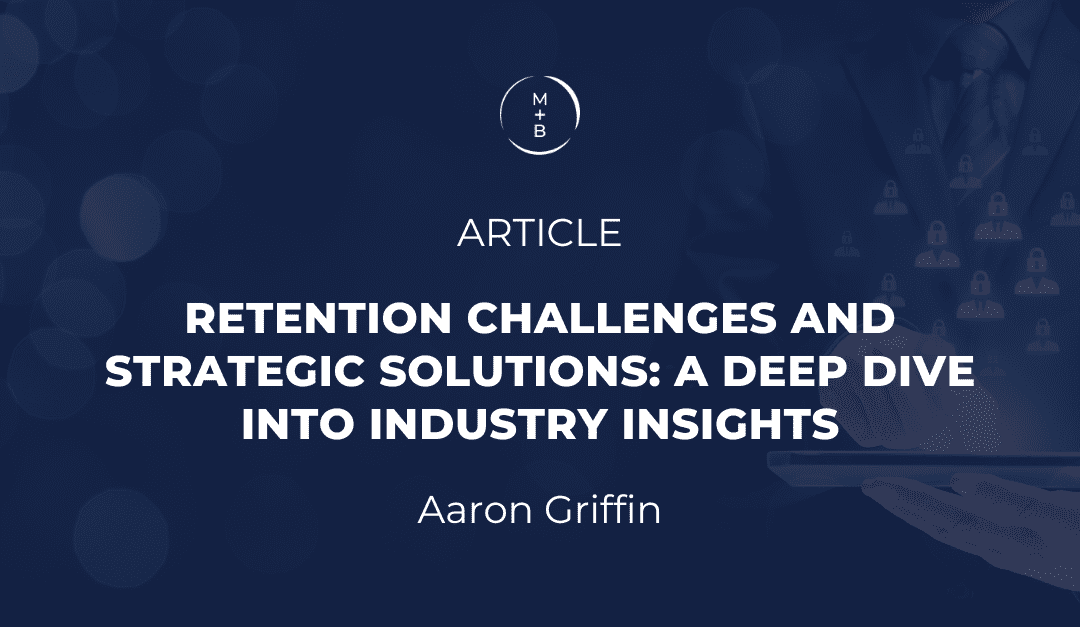Executive leader’s face a myriad of challenges in managing today’s dynamic workforce. Our Partners and Managing Directors in executive search and interim leaders interviewed 14 executive clients to uncover the major factors impacting one of the most common and difficult-to-address challenges: retention. Through our interviews, we’ve identified industry-specific issues, common challenges across all markets, and key insights to help bring the right leaders into your organization.
The retention solutions that came up throughout our conversations are ones you might have heard before. While they may not be new ideas, the ways in which you implement these solutions can dramatically change your retention outcomes. Our focus in this piece will be to share innovative ways on how to address the issues, integrate the solutions into the workplace, and leverage them to create a thriving culture.
From our interviews, it was clear that there were two main themes when it came to solving for retention:
Solution #1: Sourcing + Placing the Right Talent
The Details:
Assessing whether internal team members possess the skills, qualities, and competencies for the senior roles that will be opening.
Recruit the right leaders who will propel your strategic retention initiatives.
Source leaders who promote a collaborative culture, bridge cultural gaps, and prioritize employee welfare.
Solution #2: Leadership + Development Opportunities
The Details:
Ensure buy-in from executive leadership for culture improvements and development opportunities.
Invest in change management training, external coaching and development programs, and performance evaluation systems.
Ensure alignment with core values and ensure transparent communication.
Below, we dive deeper into the challenges presented with retention and identify the best ways to approach the above solutions.
All Industries Struggle With Retention
Across the board, it’s becoming increasingly difficult to retain employees. Factors like engagement, work-life balance, and cultural alignment have come to the forefront in recent years, indicating that employees are increasingly prioritizing work that aligns with their values, priorities, and lifestyle. Consistent themes like competitive compensation and effective management have long been discussion topics, though they’re increasingly becoming more of a reason that employees are setting their sights elsewhere. To make matters more difficult to navigate, these challenges are further compounded by the shifting expectations of a post-pandemic workforce. The pandemic changed the way people work, and though things are shifting back to the way they were before, people’s expectations and habits are not. They demand greater flexibility in where and how they work, leading to a delicate situation for companies to manage.

Through interviews with clients, and a combination of over 20 years in the executive talent market, McDermott + Bull President Brandon Biegenzahn, Partner Sue Waterbury, Managing Directors Aaron Griffin and Noelle Swan, and McDermott + Bull Interim Leaders Managing Director Julie Francis have tackled some of the hardest-hitting retention issues facing their specific sectors.

Financial Services
Financial services firms grapple with high turnover rates, particularly among entry-level and back-office roles. Firms also struggle to maintain competitive compensation packages and provide clear career advancement opportunities.

Non-Profits
Non-profit organizations often struggle to compete with the salaries and benefits offered by their competitors and other corporate entities. Employees initially attracted by mission-driven work may face burnout due to the demanding nature of their roles and limited resources.

Aviation, Aerospace, + Defense
In the aviation sector, retaining skilled technicians amidst competitive pay scales and geographical challenges remains a significant hurdle. Cultural differences, generational expectations, and leadership transitions also impact retention efforts.

Technology
Technology firms face challenges in attracting and retaining top talent, particularly in specialized roles such as cybersecurity and sales. Issues like work-life balance, burnout, and cultural alignment are key concerns among employees.
The Solutions
To better understand how to tackle these issues, we discussed implementable tools to improve retention and overall morale with leaders across multiple industries. It became overwhelmingly clear that although each sector faces their own unique challenges with retention, the solution is not inextricably linked to any specific industry, nor are the solutions brand new. The more we spoke with our executive clients, the more crossover we saw in the strategies and tactics to solve for retention, sustainable growth, and organizational stability. We also saw greater attention to the implementation of the strategies, rather than strictly identifying them. We found the most effective approach combines a strategic and thoughtful leadership recruitment strategy with a comprehensive development and culture improvement plan. We recognized two overarching themes, along with ways to apply them, that address internal change as well as solutions outside of the organization.
Looking Outward
Sourcing + Placing the Right Talent
Identify leaders who are passionate about your mission, possess the skills to navigate its unique challenges, and set a supportive tone while recognizing employee achievements and providing professional development opportunities.
Identify leaders who can redefine organizational culture, strengthen talent pipelines, and drive strategic retention initiatives.
Source leaders who are adept at bridging cultural gaps and possess the technical acumen and leadership qualities required to navigate industry complexities.
Recruit executives who prioritize employee welfare, promote a collaborative culture, implement effective talent retention strategies, foster inclusive workplaces, and encourage work-life balance.
Leverage an interim leader who excels in driving organizational change, maintaining stability during transitions, and aligning staff with company values, to create a strong foundation while searching for, and in concert with, your new permanent leadership hire.


Creating Change From Within
Leadership + Development Opportunities
Ensure there is buy-in from leadership for development opportunities and culture improvements.
Invest in change management training, performance evaluation systems, coaching and development programs, and efficiency-enhancing tools.
Boost employee engagement with employee engagement events, regular and transparent communication from senior management, and targeted training for frontline managers.
Enhance employee engagement through alignment with core values and transparent leadership communication.
Your Most Critical Retention Tools
Investing in executive search can be a game-changer for improving retention across all industries. At McDermott + Bull, we specialize in placing the right leaders within your organization to address retention challenges effectively. Our approach focuses on sourcing executives who align with your company’s culture and strategic goals, ensuring they can drive positive changes that enhance employee satisfaction and loyalty. By identifying and recruiting top talent, we help organizations build strong leadership teams that foster a supportive and engaging work environment, ultimately leading to improved retention rates and long-term success.

Finding and hiring the right permanent leader is not an immediate solution — it takes time to find the best fit for your company and your retention goals. This is where bringing in an interim leader to continue to move the needle can be of great benefit. In addition to creating a solid foundation for your new executive leader, interim leaders bring the necessary expertise to address critical gaps, launch initiatives, and create structure to ensure momentum in your retention strategy. They are adept at providing stability and maintaining organizational continuity during the transitional period of on-boarding your new executive hire, ensuring that your organization remains resilient and adaptive in the face of change.
To address the diverse retention challenges across industries, identifying top-tier executives who align with your organization’s values and strategic objectives is your most critical retention tool. Through strategic recruitment and leadership development initiatives, executive search and interim leaders can empower your organization to foster inclusive cultures, enhance employee engagement, overcome talent shortages, and thrive in a competitive business landscape.
Author
Aaron Griffin
Managing Director, Executive Search
agriffin@mbexec.com
Aaron Griffin serves as a Managing Director at McDermott + Bull and is part of the firm’s Aviation, Aerospace, + Defense Practice, based in Los Angeles. He has over 10 years of experience in executive search, supporting clients in aviation, aerospace, and transportation with their most critical hires.
Aaron brings strong expertise leading searches on a global scale. His executive network encompasses the aerospace manufacturing supply chain, aviation airport services, and the wider transportation landscape, enabling him to provide world-class talent to his clients.
Originally from the U.K., Aaron currently resides in Los Angeles and is fluent in German. He holds a Bachelor of Laws from the University of Sheffield and a Master of Arts in medical law and ethics from King’s College London. In his free time, Aaron can be found skiing, hiking, and enjoying the outdoors.
Contributing Authors
Brandon Biegenzahn
President, Executive Search
biegenzahn@mbexec.com
Brandon holds dual roles as President of McDermott + Bull and Chair of the firm’s Financial Services Practice. As President of McDermott + Bull, Brandon leads day-to-day operations for the firm as well as the strategic buildout of the firm’s team of executive search managing directors. As Chair of the firm’s Financial Services Practice Group, he is a partner to an array of financial services firms, including investment banks, commercial banks, private banks, credit unions, asset managers, institutional investors, and fintech companies.
Sue Waterbury
Partner, Executive Search
swaterbury@mbexec.com
Sue Waterbury serves as a Partner at McDermott + Bull and is part of the firm’s Education, Non-Profit, + Public Entities Practice, based in New York City, NY. Committed to value, transparency, and diversity, her collaborative approach ensures a thorough and successful search process. With more than 15 years in executive search, Sue specializes in recruiting transformative leaders for diverse organizations ranging from global enterprises to startup nonprofits.
Julie Francis
Managing Director, Interim Leaders
jfrancis@mbexec.com
Julie Francis serves as a Managing Director for McDermott + Bull Interim Leaders, where she identifies and secures highly skilled executives to address client companies’ critical business challenges, provide interim leadership, and oversee special projects. She works with executive leadership at middle-market and enterprise-level companies as well as with investment banks and private equity groups to improve operational and financial performance.
Noelle Swan
Managing Director, Executive Search
nswan@mbexec.com
Noelle serves as a Managing Director at McDermott + Bull and is part of the firm’s Technology Practice, based in New York, NY. She has over 20 years of experience in the talent acquisition industry, finding the right candidates to support her client’s needs for skill, experience, and culture fit. Her expertise spans across the broad spectrum of technology, with specific emphasis on information, communication and technology (ICT), networking, and cybersecurity.






